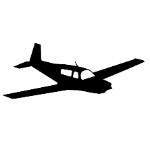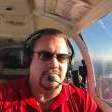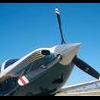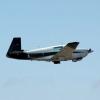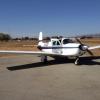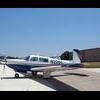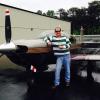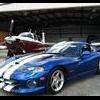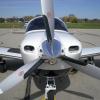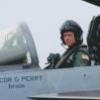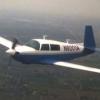Leaderboard
Popular Content
Showing content with the highest reputation on 09/14/2016 in all areas
-
8 points
-
You need to train in the airplane you fly whether it is a traveling machine or not. That is if you want to be safe. Sent from my iPhone using Tapatalk4 points
-
I am getting closer! All the CHT/EGT probes, Oil temp, two of three pressure transducers, OAT (in the wing) and tach installed. Tomorrow I am slated for finishing the fuel pressure transducer and installing the FF transducer. I will also be connecting the GPS in and out. Depending on time, the ACCUTRAK will be hooked up as well Putting the OAT in the wing required disassembly of the left interior side panels, but the extra effort was well worth it! Very tedious work today. Not hard, just tedious. For those that will maybe do this in the future: 1. Drill the EGT on the inside at a 45 as another poster suggested. It will be somewhat more difficult, but would be cleaner. 2. You will need a MOLEX crimper for the transducers. So far, outside of that, just basic tools are needed. New skill learned: Making new fuel lines! Good stuff!4 points
-
I'm following up on 201ers recent posts that provoked some mildly provocative discussions. Much was said about the stalling characteristics of the M20 which made me realize it had been 6 months or so since I'd practiced a slow-flight/stall regimen. In fact some of the talk focused on how abrupt and dangerous M20 stalls can be. I got to thinking so I went out yesterday and completed some stalls and slow flight in various configurations. Here are a few random thoughts on the subject. Comments and others' experiences are welcomed. First of all I was light at around 2,250# (2,740# gross). About 70# of my load was in the baggage compartment but the 3 seats were empty. The IAS at which I stalled was pretty much spot-on based on my weight and configuration so I feel good about the ASI calibration. It amazes me that I can fly at 50 kts in landing configuration as the plane gently settles (though it's right on the brink of a more abrupt stall). With the gear down and both full flaps/half flaps my J wanted to consistently drop the left wing when at a low power setting (as if landing). If recovery is initiated quickly (ailerons level, yoke briskly forward, opposite rudder) it would straighten up quickly with little altitude loss. But as I explored the recovery characteristics I can attest that a secondary stall can occur if the yoke is pulled back too soon (even when airspeed appears to be sufficient). I did not allow the secondary stall to develop as I understand these can be quite violent. When re-creating a full-power (departure) stall the break seems to occur a bit more quickly but was still quite manageable. With 15 degrees of flaps deployed it still wanted to break left upon stalling on the two occasions I practiced that configuration. But... On another full-power stall with NO flaps it surprised me and actually broke "right"! Though I was doing a fair job of keeping the ball centered it dropped the right wing in two consecutive instances while in this configuration. This leads me to believe that one shouldn't necessarily count on a particular direction of stall break (this is even more true when the stall is unintentional and you may not be watching the ball). Lastly, I'd like to add that it also amazes me what an incredibly acute climb angle is needed to stall in the clean/power-on configuration. I failed to note the number of degrees nose-up on my attitude indicator but I can tell you it felt/looked like I was going straight up. It was literally hanging on the prop, and still flying. I can hardly imagine putting my plane in this attitude unintentionally outside of IMC conditions. Still I'll remain vigilant. YMMV I'm attaching a screenshot from my CloudAhoy app showing just one moment in time during all this. It's pretty accurate and a great tool for analyzing this stuff.3 points
-
CloudAhoy has added much functionality over the past couple of years and can provide lots of data and great feedback if you subscribe to the paid version. And the free version is still good for tracking flights. As an added benefit just last week I utilized it to get myself out of the doghouse following a period of spending excessive time at the airport/flying. It's all about flight planning you know! Sent from my iPad using Tapatalk3 points
-
This was one of the Mod Works planes. Apparently the guy that owned it three owners ago was a dentist who flew the plane around the world. There are entries in the log books from shops in Australia. If you google N221HP there is a blog about a trip with pictures of the pyramids from the plane. It has aux tanks and can hold 96 Gals. It is definitely a unique plane with plenty of history. The last owner flew the plane non stop from Yosemite to San Antonio. He definitely had plenty of adventures in it. Putting it in new hands for someone to have new adventures was definitely an emotional experience for him.3 points
-
Things I realize this far into this discussion... 1) Some people like stalls more than others. 2) Practicing power on stalls, light on an ordinary day,. Can be much different than hot and heavy. 3) flying AOA At max power, on a hot day, into rising terrain has got to leave a very empty feeling. 4) Stalls with poor rigging adds some variability into the stall and the recovery. 5) stalls in the dark = Thrill Seeker. 6) stalls in the dark with poor rigging = screaming prayer sayer. 7) Some people have their stall charts memorized or a good handle on most of it. 8) the ball is centered in straight and level flight when the nose is kept on a target. (?) sounds logical 8.5) Cloudahoy is using GPS derived speed, unless you can have it connected to an air data computer. A couple of follow-up ideas... 9) Anyone doing steep turns while climbing out in the traffic pattern? 10) Anyone use maximum deflection of the controls in the traffic pattern? ( full rudder/aerleron deflection) Following along, -a-2 points
-
Two days after I bought my current Mooney I needed a BFR. We went out at night to do the BFR. (How many of you have done a BFR at night?) We did slow flight without incident, then I did a departure stall OMG the plane snap rolled almost inverted. I told my instructor we weren't doing any more stalls. He agreed. The plane was horribly out of rig. The yokes were at about a 20 deg angle while flying straight and level. After I fixed the rigging I went out and stalled it and it stalled very nicely and straight ahead. The bottom line is if someone says their Mooney is scary when they stall, they are probably right. If someone says their Mooney stalls benignly they are right too. If your Mooney is scary when you stall it, it can be fixed. (and your plane will probably go faster)2 points
-
On the unlimited Stevo Hinton in Voodoo qualified at 475.027, Check mate at 444.121, Dreadnought at 440.432, and Sawbones at 421.318 sport class is stacked this year, Jeff Levill qualified at 403. And John Parker 389 Talked to M20kid today and we are meeting up on Saturday you know you like fast planes so get out to the races2 points
-
Personally I think it's great that the Chinese are over here doing their training. It provides needed work for our CFI's and makes it easier for our kids to build hours and realize their dream of an ATP job at some point. Second it brings $$ back and get's them spending dollars in this country. Third, as someone who travels the world full time for work, I'm comforted to know when I'm on a Chinese carrier, the pilot was most likely trained in the US. Finally, it's pretty impressive that they speak as much English as they do. I can't imagine trying to learn anything, much less how to fly, while speaking Mandarin. Let's all be vigilant out there... "see and avoid!"2 points
-
Here in Texas I like to have my Annual scheduled for August. It's gotta be the worst month for flying. It's also right after Oshkosh and I'll likely have some new kit that needs to be installed.2 points
-
Finally got the call today that if all goes well over the few days 41M should be ready to come home next Tuesday2 points
-
Dan, As part of my relearning, I used the CloudAhoy app. It is incredibly easy to use, runs in the background on the iPad, and gives a tremendous amount of info when connected to the Internet later. for typical PP maneuvers it identifies, measures and helps you grade your skills... One of the first maneuvers I captured was a 360° turn, sans AP... for best results for T/O and landing distances, combine with a WAAS receiver, like sky radar... Best regards, -a-2 points
-
Vance, this is one of those "I'll kill you if you don't fix me right" items. Personally, I wouldn't be on a learning curve here, unless you had a knowledgeable A$P rebuild it on site. It might pay just to send it off to Don or LASAR to get it OH'd and know it is right. Your call, your butt, your wallet, Your mileage2 points
-
Any site that puts up a pilot's review should be obliged to contact the mechanic (pilot to disclose name/contact info) so that the mechanic knows about the review and could respond if necessary. Otherwise, a one way review could end up being biased. Uber for example has reviews done both ways (from driver and passenger), so an unruly, rude passenger may not get a ride in the future.2 points
-
If you want to come as far as KVAY (South Jersey Regional), I would highly recommend Jim Mancini. He trains in a Decathalon. I had an excellent experience with him about a year ago. http://www.firstaerogroup.com/2 points
-
2 points
-
I think the aviation community would be better served by a database of mechanics or shops who have signed up to a website offering their services and have reviews uploaded by customers on their experience. This allows the mechanic or shop to respond to a less than stellar experience as well as thank a customer for a good review. A database with reviews of mechanics or shops who may not even know it exists only leaves one side of an experience documented. This has the potential to negatively effect that mechanic or shop and the reviews may be completely false. Keep in mind, there are bad customers (pilots/owners) too. David AP/IA2 points
-
There you go, forcing me to think again... How much faster by moving 200 lb from the front seat to the back seat? Short answer: At higher speeds (75% power) about 0.25 knots. At lower speeds (45% power) about 1 knot. That makes sense since the weight distribution will have the biggest effect when induced drag is a bigger player. As speed increases and parasite drag becomes the main factor, the distribution has less impact. So fly fast! Long answer: Using my J POH... Assume 15 feet from CG to tail center of lift and also assuming an average weight of 2400 lbs. Moving the CG 0.1' (1.2") will change the pitching moment by 240 #'. Divide that by 15' to determine the change in tail lift required to offset the moment and you get 240/15 = 16 lbs for each 1.2" change in CG location at 2400#. Looking at my particular airplane, moving 200 lbs from the front to the rear seat moves the CG about 3.6" (or close anyway, a little poetic license). That means a change of 48 lbs change in tail lift with corresponding 48 lb change in required wing lift. Call it the equivalent of 50 lbs less weight. According to my POH, a 440 pound difference in weight makes (approximately) a 2 knot difference in speed at 75% power, about a 4 knot difference at 65% power and about an 8 knot difference at 45% power. Since the CG shift resulted in about 1/9 th that amount, I can probably assume it have an a proportional effect on speed. Now, back to football. Bob2 points
-
Just a quick shout out for another great job by Aero Comfort. The side panels came in today and looking forward to getting them installed. The new yokes and glare shield are already at the shop for install. The plane should be buttoned back up within the next few weeks. Couple of quick pics as the newly covered side panels were opened up today. I dropped the avionics panel off yesterday. The shop was resealing tanks. Figured we would reseal while they had them empty for the calibration. -Tom1 point
-
1 point
-
Cone, my understanding of Question #1 is Yes, stall happens at the same IAS regardless of conditions, for a particular weight and configuration. Regarding stalls in my Mooney, imdomthem on BFRs and IPCs when requested, but only to buffet and recovery. On my Instrument checkride, the DPE had me reduce throttle to achieve a "realistic" deck angle for the accelerated stall, simulating what would happen by accident. But I can fly around for 5-10 minutes at MCA, turning in both directions, with the stall horn blaring. In the pattern, Mike, I'm almost always at Flaps 15°/ Gear Down with bank angles < 20° until after I stabilize on final, giving a 2 mph variation at gross on your chart. I can remember that much. I account for weight in my "over the (imaginary) fence" speed by slowing down an additional 5 mph for every 300 lb I estimate below gross. Final speed = 85 mph, safely above stall; fence = 75 mph minus 5 as described if needed. No stall buffets in the last nine years; no steep banks in the last nine years; hand on the throttle if needed for the last nine years. Use your head a little, it works well. Nite that this keps me safely away from the edges of the performance envelope.1 point
-
This is why AOA indicators are so valuable imho. Sure ok you memorized the stall speeds for *level flight* at every weight and bank angle combination, and throw in configuration too. How about a climbing turn? A descending turn? I want an AOA indicator for xmas. Sent from my iPhone using Tapatalk1 point
-
Check to see if the dog O2 is in reality a requirement. There was another MSer in flight training that was looking into it. 1) If it's important, the equipment to know it's working doesn't seem realistic. How do you test the O2 level on a dog. 2) especially if he's gone to the baggage compartment to hide out... 3) how do you know the ear protection is working? Is he visibly more comfortable? my dog won't answer my questions... Best regards, -a-1 point
-
None of the above. Just the only time we were both available and I had a trip the next day. I don't go out of my way to do stalls in the dark, but I'm not afraid of them either.1 point
-
John- since you obviously care about how your mechanic perceives you, you are not one of the bad ones. Here are a couple of examples that spring to mind. I was working at a shop in central Texas and helping on a Bonanza annual. The owner needed new engine mounts, so we installed them and replaced his old semi-rusted engine mount bolts and nuts. When he got his bill, he complained that we shouldn't charge him for new hardware because his old hardware was just fine. (About $20.) The shop owner took the hardware off his bill because it wasn't worth the argument. The guy got in his brand-new Mercedes Benz and drove away. Our shop rate (mid '90s) was $45/hour. The rate at the Mercedes dealer was probably $70/hour. It annoyed us that the guy probably just stroked a check when he got his car worked on, but had to argue about $20 with us. --------- I did an annual on a Mooney. The owner had been taking his airplane to a big shop (not an MSC) and paying about $3000/year (about 12 years ago). We charged him less than $1500 and did a fair amount of work. A few days later he came back complaining that all of his inspection panels had loose screws and he had to tighten them all himself. I asked to see what he meant, and he put his electric drill/driver on and cranked them down way too tight. (This explained why we had such a hard time getting them off.) I showed him the reference from the Service Manual (see the NOTE: below) but he continued to bad-mouth us to other airplane owners that we did sloppy work.1 point
-
Nope. This is because real power-on stalls don't happen that way. I've had some close calls to power on stalls on departure when heavy at high DA. There are a couple of things working against you and the pitch attitude never looks like that crazy laying on your back with your instructor power on stall. Firstly, when you go practice stalls, you are usually pretty light (you + instructor or just solo). The plane has way more power available so the vertical component of thrust is significant. Maybe try it at reduced throttle. Next, on that day that you get yourself in a bind with a power on stall, you probably have all of your fat friends and luggage on board. CG will be further Aft! Most likely this won't be in winter either. Hot Day, higher DA, or actually the one time you go to a higher elevation field. Next, a little bit of uncoordinated flight (perhaps not enough or too much right rudder in the climb). Perhaps a bit of a turn? The biggest issue is going to be the speed lag on takeoff and breaking ground effect. The angle of attack ends up higher than you expect at a lower pitch attitude. You'd be way behind the power curve and barely or not climbing at all. It will look like a pretty much normal pitch attitude. Definitely not the laying on your back pointless power on stall the instructor made you do. The solution? Fly by angle of attack and not by airspeed. Preferably an AOA indicator, but even just forgetting about airspeed values and thinking about the angle of attack of the airplane in each configuration. If you reference Vx and Vy as angles of attack and not as airspeeds, you are more likely to get better performance (which makes you less likely to inadvertently pull back) while also having greater stall margin. Vx/Vy are typically referenced in the POH for gross weight at sea level at standard temp. Guess what? Accidents tend not to happen under ideal conditions. I'd bet you many of them are at higher than standard temp/altitude (if not over gross). So the POH published numbers will be least helpful when you need them most! Fly by AOA. That's the only thing that actually affects the wing.1 point
-
You sure got that right! Strangely enough the landing was one of my best ever; so much so that I went home and bragged to my wife about it. She wasn't impressed.1 point
-
Never. What's the point? It was a traveling machine, not a trainer.1 point
-
I did a series like that about 8 mo ago. I played with decent rates. Power off 360s with aggressive bank angles. With the prop back I was shocked I could do a 360° turn at 85kts in about 400 feet. Very good idea to practice. However, if your not comfortable, find some one who is. It will be worth your time. Flysafe, -Matt1 point
-
Bought my plane out of Utah and had it flown to Longview, TX for pre buy by Don Maxwell. Happy to share details if you have any specific questions. Better the pre buy, fewer headaches in your first year or two of owning.1 point
-
You got me wondering about this so yesterday I measured the distance between the wing and horiz stab on my '78 J. Can somebody provide similar measurements on a SB and a LB for reference? See pics but I measured between the inboard flap corner and the leading edge of stab at the rib ~directly aft of that point. The distance was ~93" (hard to be precise doing this solo). Sent from my iPad using Tapatalk1 point
-
don't forget you need to empty the tanks before removing it. I know captain obvious here but worth a reminder. I have not completely disassembled one before but I imagine withe a diagram and the proper o rings it should not be difficult for you and you mechanic.1 point
-
1 point
-
1 point
-
Special thanks to MSers Mark and Andy who came to the hangar to help. The mechanic Tim did a very thorough examination testing the solenoid, relay, and each of the wires. Rather quickly Andy, Mark, and Tim found a very loose multi-pin connector that was the culprit. It was under a bundle of wires and the one with the most nimble fingers reconnected it. The photo shows 1/2 of the connector. Great response online and in person! Thanks! Ray1 point
-
It's easier moving South, you just have to listen slower. When I went north, I had a hard time understanding everyone, they talk so durn fast! To say nothing of the funny accent . . .1 point
-
When I came down south 37 years ago I had no idea what folks were saying. Now I'm totally fluent!1 point
-
From another forum: Directly from witnesses. The Bonanza radio was not tuned to Carrollton CTAF but to Newnan. He was on final. The student and instructor turned base to final into and below the bonanza. The are giving the instructor credit for not looking. But evidently neither was looking.1 point
-
I do it all the time. I just went KPCW YQG KAPN You will probably be with Cleveland Center the whole time (depending on altitude) You may want to carry your passports just in case you have an unplanned stop. You do need to be on a flight plan, have a squawk code and talking with ATC when you cross the border.1 point
-
That thing helped land my my current airline job: It held the hangar that hung my suit that I wore to the job fair that I flew my Mooney to... sort of has a nice ring to it.1 point
-
1 point
-
Start with your budget, then determine your mission. Those two variables will likely help you determine which model.1 point
-
1 point
-
I am based at CCO where the flight school involved in this accident is based. I agree that this issue of soft spoken foreign student pilots is a real problem. The Falcon students too often speak softly, quickly, and with strong asian accents. I almost had my own incident caused by not being able to understand the student pilots. Fortunately just before I turned to join the downwind an instructor who was apparently DUAL with one of the students broadcast a position report and clarified their position That position report that I understood just before joining the pattern caused to me to turn away from the airport and avoid a close call. Prior to the instructor speaking, I had no idea where the multiple students in the pattern were located even though they were making unintelligible position reports. I was listening to and interacting on the CTAF at least 10-15 miles from the airport. At least half of the radio transmissions from Falcon students are unintelligible to my ear.1 point
-
The news media will never change. They have been the same for 200 years. I've watched it in aviation for 50+ years. It's all about readership and sales. Sensationalism sells newspapers (or what ever media).. No matter the prognostications about "reporting the news", editors always want the storyline "punched up" to grab attention. It will never change. Who can ask the most salacious question, who can use the Thesaurus the best. Just look to local "news" programs and the choice of their verbiage and tonal inflections every evening. You're beating a dead horse if you think it will ever change.1 point
-
If you dont mind, let not use any names or 'scenarios' if you go to report him., I dont want it somehow being tied back to me. The plane is a SR20; Flight Club is West Valley; DPE is Tom H.... he has been around for a while so i will guess you know him. The problems with the plane weren't exactly horrible. The fuel flow gauge in the dash is a back up to the one in the avionics; The NAV2 HDI was off, but the rest of the Garmin 430 was perfectly fine. NAV1 was also fine; The biggest problem I think is probably the ALT2 light, which then causes the BATT2 breaker to pop. Some times its fine, other times its not,. so its grounding out somewhere. Oh and the #4 CHT probe is broken; it inconstantly reads bad temps. Thats been happening since my Solo XC. The plane has almost 1900 hours on it since OH, its due for a lot of TLC. I dont think its a accident waiting to happen; there are a lot of issues; but nothing that i would consider dangerous. Not every plane has redundant alternators or batteries, so i wouldn't say that its more dangerous than any of those. ' I will say that the DPE does have something against cirrus. A lot of times i was corrected with information that would work in a 172 but could be fatal in a cirrus. IE after my last test he said 'during your pre take off briefing you said you would pull the chute at above 500' on take off if the engine failed. I would never do that, you should always fly the plane. What if you were at 498' would you still do it?' I asked what my alternative was; 'You should land straight ahead'...... Uhhh, straight ahead is either the Facebook parking lot, a marsh with no smooth surfaces, or a ocean'..... No at 500' im pulling the chute and landing safely in the marsh. We then got into a discussion about impossible turns. He asked if i practiced them, i said no. He said i should and that a good pilot can make the turn back to the runway at about 1000'. Well, in a SR20 1000' is about 2nm from the airport. so you are not going to make it back. Not only that, but there are documented fatalities while trying to practice it. I want to be a safe pilot, i want to be a good pilot... I dont want to be a dead pilot. I would have been more than happy to do nor flaps or engine out at mid field at KLVK or KRHV; but not KPAO.1 point
-
For anyone following this project..Panel is powder-coated, finally found a shop that actually wanted my business and returned calls, even tossed him a pretty nice bonus tip for getting them done quickly and being efficient (turned out great I think). Having the identifier marks put on now. Switches have been installed on the new yokes and Hector from AComfort emailed saying the newly recovered sidewalls and dash are with Fed Ex and headed this way. Hopefully just 2-3 more weeks and we are flying again. Only been down since first week of July. Getting anxious. -Tom1 point
-
When we first started the upgrade I was not considering the Aspen. When I finally got down to business and decided that 41M would be a keeper for a while I added the Aspen. This morning my avionics shop reworked the first quote to backout $ from the extra GPSS box bringing the cost of the STec AP down some since we had the Aspen in the game plan now.. I know it gets confusing since I started looking at just upgrading the auto-pilot. Funny how 10K turns to 30k+ in heartbeat... I need to stay off this forum and away from all the fancy ideas..We always enjoy spending each others money..right? Sorry for the late reply..I was busy checking the couch cushions for loose change -Tom1 point
-
1 point


